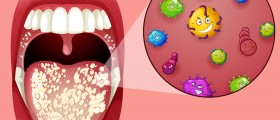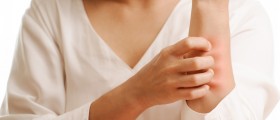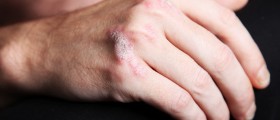Jock itch, medically known as tinea cruris, is a fungal infection that normally affects the groin. The jock itch may also transfer to the skin around the genitals, inner tights, penis, scrotum, labia, vaginal opening, and buttocks. This common itchy rash can be very intense, and it is usually seen in men, but women may get the jock itch, too. Patients with diabetes and obesity are at a somewhat higher risk of developing this fungal infection. The name “jock itch” refers to the nature of this condition, as it often occurs in people who sweat a lot.

Symptoms of Jock Itch
The symptoms of jock itch may come and go, and in many cases this unpleasant condition resolves spontaneously without any treatment. The itch is characterized by a symmetrical red or pink rash on the sides of the groin folds. It may differ in appearance, from a dry and scaly rash to a collection of small red or pink bumps at each hair follicle. Some of the patients may complain about flaking, peeling, or cracking skin and itching in the anal area. The itching is often accompanied by a burning sensation.
Causes of Jock Itch
Jock itch is caused by a particular type of fungi called Dermatophytes. The same type of fungi causes athlete’s foot and ringworm. These fungi normally live on the human skin, but like any other type of microorganism, fungi flourish in dark and moist areas of the skin.
The overgrowth of fungi is sometimes caused by irritation from tight or abrasive underwear, excess moisture, sweating, skin rubbing or friction, allergic problems, fungal infection, Candida infection, and bacterial overgrowth or skin infection. Patients with diabetes, obesity, and those with a compromised immune system like HIV/AIDS, hepatitis, chronic illnesses, cancer, systemic chemotherapy, immunosuppressive drugs like Prednisone, may be more prone to jock itch.
Is Jock Itch Contagious?
The answer is – yes. Jock itch can spread from one to another by sharing the same contaminated towels or clothing. Another common route of transmission is through direct contact during sexual intercourse.
However, jock itch is preventable, but it requires good general skin hygiene and keeping your groin clean and dry. The groin and buttocks should be washed with soap, especially after exercise and excessive sweating. your work clothes, underwear, and swimwear should be washed and replaced after each use.
One should always wash clothes and underwear in hot soapy water. White cotton underwear will minimize groin moisture, and polyesters, nylon, or synthetic fibers could aggravate the condition.
- Tinea cruris is caused by dermatophytes belonging to three genera, Trichophyton, Epidermophyton, and Microsporum. Trichophyton rubrum has been isolated most commonly and remains the most frequent cause of tinea cruris worldwide; however, most studies do recognize the increasing prevalence of Trichophyton mentagrophytes and other organisms in certain regions. Several risk factors have been identified that predispose an individual to tinea cruris, including excessive perspiration, occlusive clothing, improper hygiene, diabetes mellitus, immunocompromise, and lower socioeconomic status.
- Cutaneous mycoses, including tinea cruris, affect 20 to 25 percent of the world's population. Developing and tropical countries have an increased prevalence of dermatophyte infections secondary to high temperatures and increased humidity. In the United States, there have been an estimated 29.4 million cases of superficial fungal infections and over 51 million reported physician visits. Adolescent and adult males comprise the majority of patients seen for tinea cruris and are affected by the disorder with increased frequency. Worldwide increases in the occurrence of dermatophytoses and the discovery of recalcitrant infections have caused global concern.
- A simplified explanation of the complex and not well-understood pathophysiology of dermatophytes includes the organism's use of proteinases to digest keratin found in the skin's stratum corneum.
- Antifungals utilized in treating dermatophytoses, including tinea cruris, target the synthesis of ergosterol, a vital component of fungal plasma membranes. Management strategies are similar worldwide; however, some countries have specific guidelines based on their region's fungal profile. Topical therapies are effective and usually preferred. Allylamines (terbinafine, butenafine, naftifine) and azoles (clotrimazole, miconazole, sulconazole, oxiconazole, econazole, ketoconazole) are the mainstays of topical treatment regimens. They are generally prescribed once or twice daily for two to four weeks.
- While tinea infections are often classified by the location of the body affected, they are also organized according to the responsible organism's primary source and mode of transmission. Geophilic, zoophilic, and anthropophilic fungi are found in and transmitted by soil, animals, and humans, respectively. Autoinfection of dermatophytes is also possible and especially crucial in tinea cruris as foot-to-groin spread can occur.
- A commonly used alternative treatment known as Whitfield's ointment has insufficient evidence of benefit. Nystatin, a frequently utilized treatment for cutaneous candida infections, is ineffective for managing dermatophytoses such as tinea cruris. Combined topical corticosteroid and antifungal therapy remain controversial. Some studies have demonstrated improved cure rates with concomitant steroid and antifungal topical applications; however, these results were based on low-quality evidence.
- www.betterhealth.vic.gov.au/health/conditionsandtreatments/tinea
- www.cdc.gov/parasites/swimmersitch/faqs.html
- Photo courtesy of Orrling and Tomer S by Wikimedia Commons: commons.wikimedia.org/wiki/File:Itch_02.JPG

















Your thoughts on this
Loading...